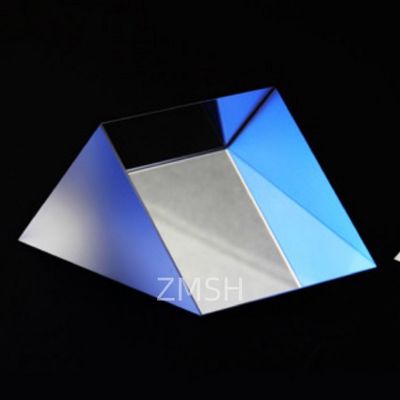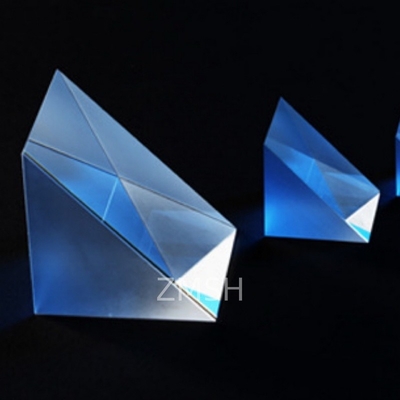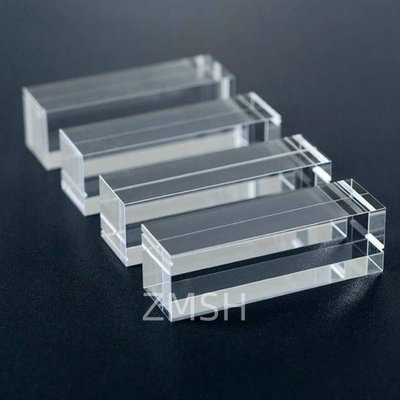Quartz prisms
Product Details:
| Place of Origin: | China |
| Brand Name: | ZMSH |
| Model Number: | Quartz prisms |
Payment & Shipping Terms:
| Minimum Order Quantity: | 2 |
|---|---|
| Price: | 20USD |
| Packaging Details: | custom cartons |
| Delivery Time: | 2-4 weeks |
| Payment Terms: | T/T |
| Supply Ability: | By case |
|
Detail Information |
|||
| Material: | Quartz | Refractive Index (@587 Nm): | ~1.458 |
|---|---|---|---|
| Thermal Expansion Coefficient: | 0.55 × 10⁻⁶ /K (near Zero Expansion) | Transmission Range: | 180 Nm (deep UV) ~ 2.2 µm (near IR) |
| Chemical Stability: | Acid-resistant, Corrosion-resistant | Radiation Resistance: | Suitable For Aerospace And Nuclear Environments |
Product Description
Definition
A prism is an optical element in which one or more reflective surfaces are ground into a single piece of glass. It functions to redirect light paths, invert or rotate images, and can be considered as a combination of planar mirrors. Prisms are widely used in laser research, laser optical systems, optical imaging, machine vision, life sciences, and biomedical applications or products.
Prisms can not only deflect light but also adjust image orientation. The design of a prism determines how it interacts with light. When light enters a prism, it may reflect off one or more surfaces before exiting, or it may be refracted as it passes through the prism.
Features
| Type | Features |
|---|---|
| Right-Angle Prism | 1. Deviates light path by 90° or 180° 2. Used in image/light path redirection |
| Wedge Prism | 1. When used alone, deflects the beam by a specific angle 2. When used in pairs, enables beam shaping or deviation control |
| Pentaprism | 1. Deviates light path by 90° 2. Maintains image orientation without inversion or reflection |
| Dove Prism | 1. Rotates the image by twice the prism’s rotation angle 2. Output beam remains aligned with the original beam direction |
| Hollow Roof Mirror (Reflective) | 1. Deviates light path by 180° 2. Reflective surface is coated with aluminum |
Applications of Quartz Prisms
Quartz prisms are widely used in precision optical systems due to their excellent UV transmission, thermal stability, chemical resistance, and low birefringence. Their ability to precisely manipulate light paths through refraction and reflection makes them ideal for high-performance optical applications. Key application areas include:
1. Laser and Optical Systems
-
Used to redirect, split, or combine laser beams with high precision
-
Ideal for high-power laser systems due to quartz's high damage threshold
-
UV-grade quartz prisms are essential in excimer laser setups and beam steering assemblies
2. Spectroscopy and Analytical Instruments
-
Serve as dispersive elements in spectrometers for separating wavelengths
-
UV-transparent quartz prisms are used in fluorescence and absorption spectroscopy
-
Enable precise angle-dependent analysis of optical signals in scientific instruments
3. Imaging and Vision Systems
-
Correct and manipulate image orientation in microscopes, cameras, and telescopes
-
Employed in pentaprisms, right-angle prisms, and Dove prisms for image rotation or redirection
-
Common in machine vision, biomedical imaging, and inspection systems
4. Photonics and Communication
-
Quartz prisms serve as polarization rotators, beam steering elements, or wavelength separators in fiber optic and photonic circuits
-
Used in the design of optical isolators and modulators due to quartz’s stable refractive index
5. Metrology and Alignment Tools
-
Integrated into autocollimators, alignment scopes, and surveying instruments for accurate angle measurement and beam deviation
-
Provide reliable reference angles in interferometry and calibration systems
6. Aerospace and Harsh Environment Optics
-
Quartz prisms operate reliably in vacuum, high-radiation, and high-temperature environments
-
Used in satellite imaging, spaceborne spectroscopy, and defense optics systems
FAQ
Q1: What is a quartz prism and how is it different from standard glass prisms?
A1:
A quartz prism is an optical prism made from high-purity crystalline or fused quartz (SiO₂), known for its excellent UV transmission, thermal stability, and chemical resistance. Compared to standard glass prisms (e.g., N-BK7), quartz prisms can operate in deeper UV ranges, withstand higher temperatures, and are more suitable for harsh or high-energy environments.
Q2: What wavelength range can quartz prisms transmit?
A2:
Quartz prisms offer a wide transmission range, typically from 180 nm (deep UV) to 2.2 μm (near-infrared). This makes them ideal for ultraviolet lasers, fluorescence spectroscopy, and IR beam steering.
Q4: Are quartz prisms resistant to high temperatures?
A4:
Yes. Quartz has a high thermal stability with a softening point around 1,620°C and excellent resistance to thermal shock. This makes quartz prisms suitable for high-power laser optics and high-temperature measurement systems.







